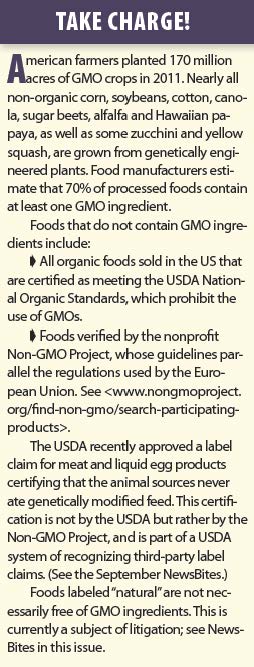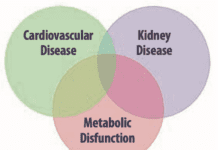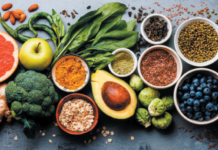You can hardly pick up a newspaper these days without reading about the debate over labeling genetically modified (GMO) ingredients in foods. This summer, following the narrow defeat of a GMO-labeling initiative in California, Connecticut and Maine passed labeling legislation that would go into effect if other states follow. On Nov. 5, Washington State voters will decide on a ballot initiative, I-522, The Peoples Right to Know Genetically Engineered Food Act. The Chipotle food franchise recently started identifying menu items with GMO ingredients on its website, and the Whole Foods grocery chain announced it would require GMO labeling in its stores by 2018.


Whats often obscured in the heated debate over GMO labeling is whether such foods, first introduced in 1996, actually pose any threat to your health.
No harm has been demonstrated with ingestion of these foods from genetically modified plants, says Irwin H. Rosenberg, MD, University Professor at Tufts Friedman School and editor of the Health & Nutrition Letter. The opposition, while raising questions of safety, has actually been cultural rather than scientific. Even arguments against GMOs on environmental impacts have not been supported empirically.
The American Medical Association, in a statement passed this summer, agreed that there is no proven risk in foods containing ingredients whose DNA has been modified. That stance echoed the World Health Organization and a National Academy of Sciences white paper that concluded there is no evidence of any hazards from genetically modified foods; in a recent article in the prestigious journal Science, leading scientists also strongly endorsed the safety of GMOs. Nonetheless, in a sign of just how controversial this topic has become, the AMA hedged its bets and called for a mandatory safety approval process before such foods hit the market.
OMNIPRESENT INGREDIENTS: Unless you consume only certified organic foods, which cannot contain GMO ingredients under US Department of Agriculture regulations, youve almost certainly eaten foods containing ingredients whose genes have been tweaked to resist pests, grow more easily or boost nutrients. According to testimony at the AMA hearing, 94% of soybeans, 88% of corn and 90% of cotton (used to make oil as well as clothing) grown in the US has been genetically engineered.
Most GMO corn and soybeans are fed to livestock. Field corn is also ground into cornmeal for tortillas, chips and muffins, however, and is used to produce corn oil and high-fructose corn syrup. GMO soybeans are also processed into oil and soy lecithin, a common emulsifier. Sugar beets, but not sugarcane, are 95% GMO. So are the plants used in canola oil-about 90% of the US crop.
Processing, however, eliminates almost all the modified genes and the proteins they produce. Because most GMO plants are heavily processed before reaching consumers, actually very little of the engineered genes wind up in your grocery store. Most fresh produce-not just organic choices-sold individually does not come from GMO plants; the exceptions are most Hawaiian papayas and some zucchini and yellow squash.


DESIGNER GENES: Given the controversy over GMO foods, why would anyone grow them? Proponents cite successes in engineering crops that require less water, herbicide or pesticide (or even produce their own bug-resistant chemicals). Florida citrus growers are testing transgenic orange trees, engineered with the addition of a gene from spinach to help resist the bacteria that causes citrus greening. Spread by insects called psyllids, the disease threatens the states orange crop and Americas thirst for orange juice.
Dr. Rosenberg notes, Its important to distinguish among foods such as corn and soy, in which genetic engineering is directed at protecting the plant from pests or weeds, with no modification made to the actual kernel or bean, and those in which the food itself is changed for nutrition reasons.
An example of the latter would be Golden Rice, developed for Third World countries-rice that has been modified by the addition of a gene from corn and another from a bacterium to produce beta-carotene, a precursor to vitamin A. Tufts research led by Guangwen Tang, PhD, showed that the beta-carotene in golden rice is better than that in spinach at providing vitamin A to children; one bowl of rice delivers 60% of the daily requirement. Vitamin A deficiency is responsible for 250,000 to 500,000 cases of blindness in children annually, and contributes to some 2 million deaths from weakened immune systems in Asia and Africa. Nonetheless, the Philippines government is still weighing whether to approve the expansion of golden rice beyond five small field trials-one of which was vandalized by 400 protesters in August.
In the US, however, Dr. Rosenberg says, Nutritional arguments for the use of nutrient-enhanced foods like Golden Rice for vitamin A deficiency have not been in the public arena.
As a practical matter, for now, the GMO foods youll find on supermarket shelves fall into the category of having been engineered for increased yields, rather than nutritional enhancement.
HYBRIDS OR HAZARDS?: These genetic manipulations are possible because all life shares a common biochemistry. A gene that helps fish tolerate cold could have the same effect in tomato plants-without making the tomatoes taste fishy, since flavor comes from other genes. The gene added to make GMO corn insect-resistant, in fact, comes from the same bacterium organic growers use as a natural insecticide.
Advocates argue that genetic engineering is little different from the hybridization that humans have employed for centuries to make plants more useful. Before human intervention, after all, corn was only a wild grass, dairy cows produced little milk and carrots were only occasionally orange. In the past 50 years, scientists have augmented hybridization with chemicals and radiation aimed at causing desirable mutations in plant DNA.
Critics charge, however, that GMO crops are being (almost literally) shoved down our throats by giant corporations motivated only by profit, with little regard for safety. Testifying in support of Washington States labeling initiative, Kenneth A. Cook, president of the Environmental Working Group (EWG), cautioned that the only early warning system of potential GMO hazards rests entirely with the companies that stand to profit from their continued sale.
In particular, anti-GMO protesters have focused on Monsanto, whose bioengineered seeds produce 90% of GMO crops. (Neither the Florida orange project nor Golden Rice, however, is owned by Monsanto.) The companys control of GMO seeds gives it a stranglehold on farmers, critics charge, and the dominance of GMO strains risks a loss of genetic diversity.
Other critics, such as Greenpeace, also worry that GMO crops might have unforeseen environmental consequences. Some see GMOs as possible culprits in the decline of Monarch butterfly populations and the collapse of honeybee colonies. Those seeking to block USDA approval of a genetically engineered salmon species voice concerns about the fish escaping to the wild and contaminating the gene pool of native species.
WEIGHING THE EVIDENCE: You may share such environmental and economic concerns, which could be reason enough to avoid GMO products on ethical grounds. (See box.) The labeling rules that have been proposed in more than two-dozen states-modeled on those already adopted by some 60 countries including the European Union-would make it easier for you to stick to such principles. Most such requirements, however, such as the Washington State initiative, would not demand labeling of restaurant foods or meat from animals given GMO feed.
But what about potential health risks from GMO foods? Given the difficulty and expense of avoiding such ingredients, if your worries about GMOs are purely personal, is it worth it?
GMO critics cite fears that the proteins in such foods could cause new allergies or adverse effects on the immune system of humans. In the 1990s, in fact, an allergen from Brazil nuts was inadvertently transferred to GMO soybeans; because this was discovered, the soybeans were never commercialized. But there is no evidence of any human allergic reaction caused by food grown from GMO crops grown in the US.
Critics also point to a long list of animal studies published in peer-reviewed academic journals that show differences between those fed GMOs and a control group given non-GMO foods. These differences in organ response, immune system, gut bacteria and other factors are called not biologically relevant by scientists who maintain that GMOs are safe.
In generally affirming the safety of GMO foods, the American Medical Association called on the FDA to remain alert to new data on health consequences of bioengineered foods and to update its policies accordingly. The Environmental Working Group, which does not oppose the use of genetic engineering in agriculture per se, says that much more robust, independent and impartial government pre-market health and safety standards and procedures are needed.
In the meantime, whats a health-conscious consumer to do? Says Tufts Dr. Rosenberg, Given the in-depth review of the safety of these foods by our leading scientists in the National Academy of Science, we can confidently, I believe, include such foods in our diets as we have ingested hybrid foods through all the history of mankind. If you are opposed on cultural grounds to technical modification of the natural order of plants, inform yourself about alternative approaches to global efforts to safely feed the worlds population, expected to reach 10 billion by 2050.
























